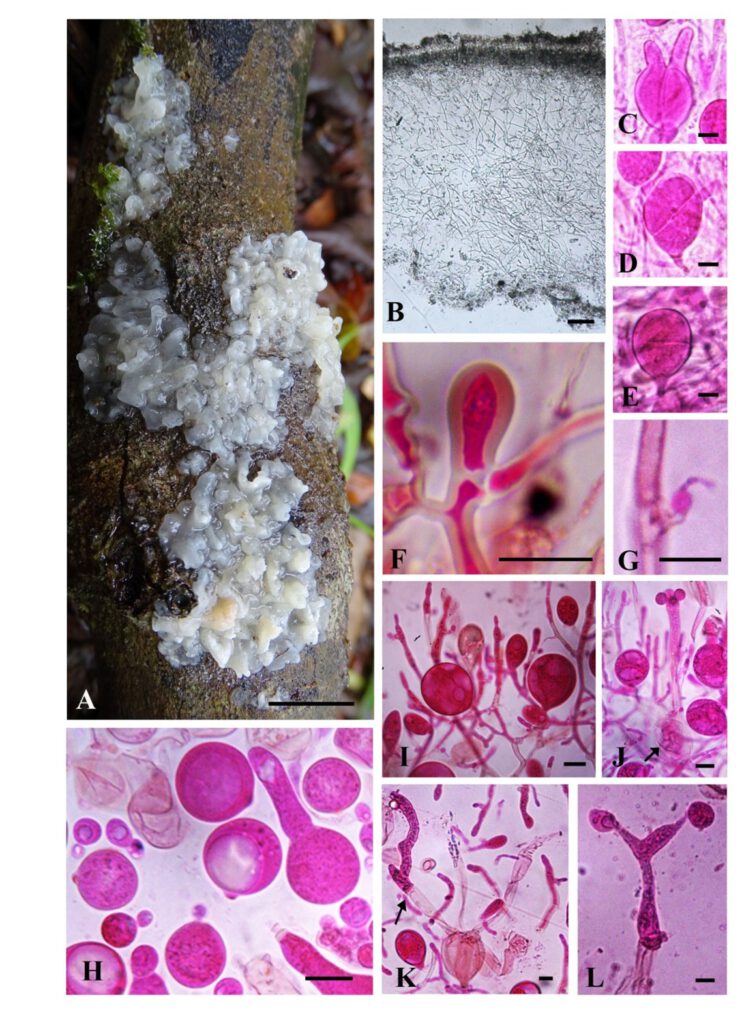Tremella sairandhriana A. Thomas & T.K.A. Kumar
MycoBank number: MB; Index Fungorum number: IF; Facesoffungi number: FoF 11779;
Description
Basidiomata medium sized, 10—45 × 1.5—3.5 mm, soft gelatinous, resupinate, cerebriform, sessile, broadly attached, easy to separate from the substratum, margins sometimes wavy, tiny lobes projecting upward, white to pale yellowish white when fresh and pale yellowish brown when dry. Spore print whitish.
Hymenium pale brown in water. Hyphidia 3—7 µm, branched, septate, thick-walled, with clamp connections. Basidia 27—35 × 26—27.5 µm, globose to subglobose, four or two celled, longitudinally, transversely (rare) or obliquely septate, thin-walled, guttulate, hyaline with basal clamp connection. Basidioles clavate to obovoid. Sterigma 59—96 × 6.5—9 µm, sometimes with swollen tip (swollen upto 11 µm), septate, branched, occasionally producing conidia. Conidia from sterigma 3—7 × 3—7 µm, globose, hyaline, smooth, thin-walled. Basidiospores 16—19 × 17—20 µm (Q=0.84—1 µm, Qm= 0.956 µm), globose to subglobose, hyaline, thin-walled, smooth, guttulate, apiculate, broader than long. Secondary spore production and yeast cell formation from basidiospores observed. Yeast cells 3—7 × 3—7 µm, globose, subglobose, broadly ellipsoid. Vesicles 10.4—12.7 × 5.9—7.8 µm, ellipsoid, oval, thickwalled. Swollen cells absent. Tramal hyphae 2—5.5 µm wide, slightly thick to thick-walled, branched, smooth, hyaline, frequently anastomosing, with clamp connections and pseudoclamps. Haustoria abundant on hyphidia and subhymenium, rarely branching, with basal clamp connection, sometimes with forked tip.
Material examined: INDIA, Kerala State, Palakkad District, Silent Valley National Park, on dead and decaying wood log, 04 July 2019, A. Thomas (ZGCAT89, holotype)
Distribution: Silent Valley National Park
Sequence data: ITS: ON668076 (ITS1/ITS4); LSU: ON668075 (LROR/LR7)
Notes: Tremella sairandhriana is characterised by whitish, resupinate basidiomata, presence of hyphidia, globose to subglobose basidia, formation of condia from sterigmata, and rarely branching haustoria. Among the whitish Tremella members, T. sairandhriana showing closest similarity to T. resupinata with the resupinate nature of basidiocarp and larger size of basidia and basidiospores. But T. sairandhriana have large sized basidiocarps, and branched, septate, thick-walled, clamped hyphidia, and formation of conidia from sterigmata which is absent in T. resupinata (Chen 1998).

Fig.1 Tremella sairandhriana (ZGCAT89, holotype). A Basidiocarp. B Cross section in water. C-E Diferent septations in mature basidia. F Vesicle. G Haustoria. H Basidiospores, budding and germination via germ tube. I Hyphidia with basidia of different developmental stages. J Collapsed basidia (Arrow) and conidia from its sterigmata. K Septate sterigmata (Arrow). L Bifurcating sterigmata bearing basidiospores. Scale bars: A=10 mm, B=30 µm, C—L=10 µm.
